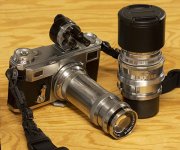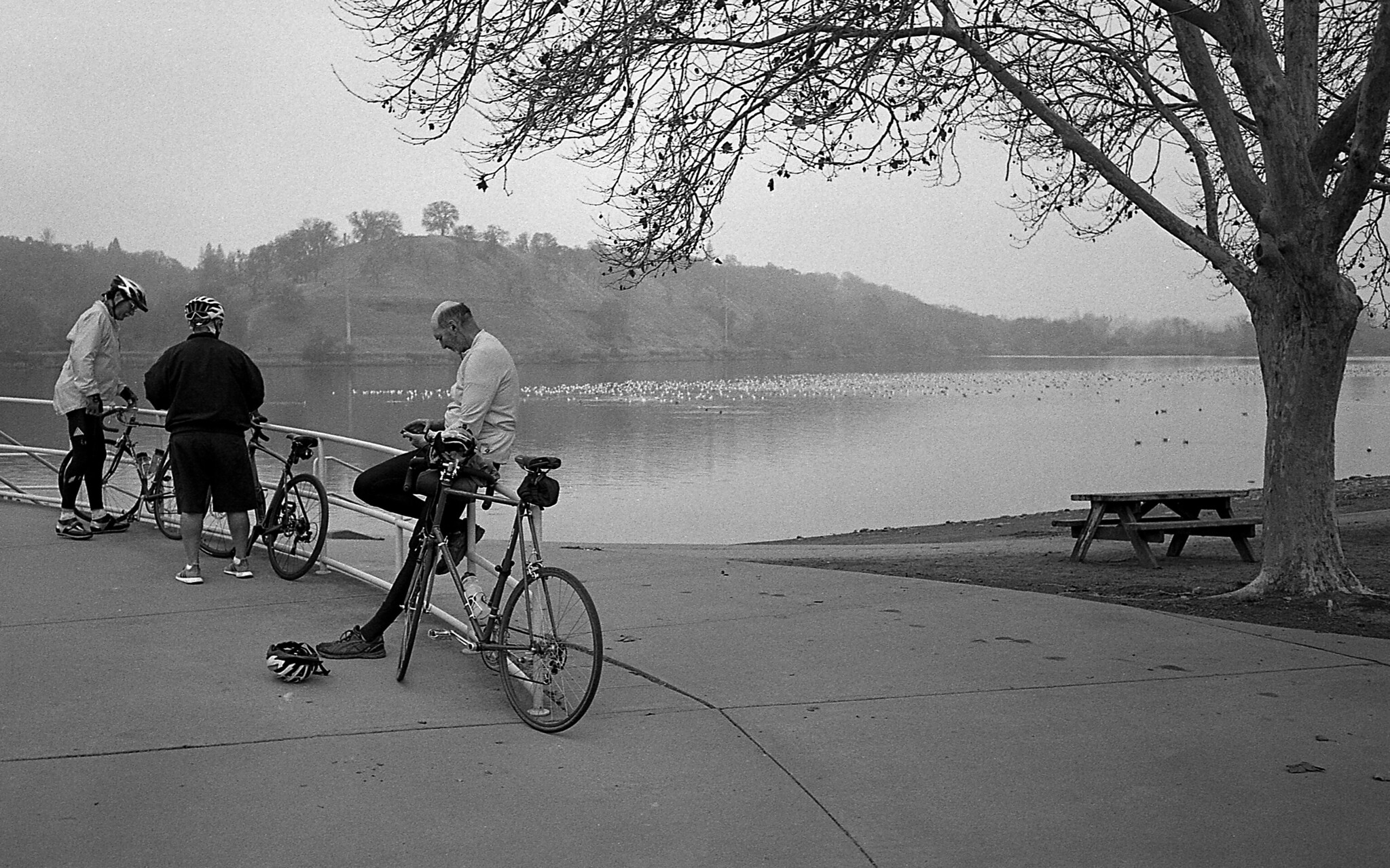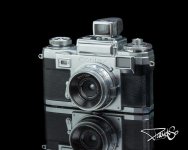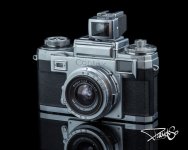Wartime Jena 35/2.8 Biogon - Rangefinder Coupled - Does NOT mount on IIa - (4 groups / 6 elements)
Usually coated. Rare. Similar to the uncoated pre-war Biogon, but with better contrast. All copies of these lenses seem to fall into the 2.6xx.xxx serial number range and usually in aluminum finish. Focus does not feel as smooth as their brass contemporaries, but they are about 70grams lighter. (5.3oz vs 8.1oz) Unlike their their un-coated brethren highlights do not spread out as easily, color reproduction is good.
Finder: See 35mm Biogon entry.
---
Post-war Jena 35/2.8 Biogon - Rangefinder Coupled - Does NOT mount on IIa - (4 groups / 6 elements)
All coated. Rare. Similar to the coated and un-coated pre-war Biogons. All copies of these lenses seem to fall into the 3.xxx.xxx serial number range and are exclusively in aluminum finish. Fit and finish is slightly reduced, however the optical formula appears to have been tweaked (new glass types?) central acutance is extremely high, akin to a good sample of a Jupiter-12.
Finder: See 35mm Biogon entry.
---
Pre-war Nickel Jena 50/2.0 Sonnar - Rigid - Rangefinder coupled - Mounts on IIa - (3 groups / 6 elements)
All uncoated. Rare. Nickel and brass finish. Two optical variants. Many variations in appearance and aperture mechanism. The rear doublet has been enlarged from 19mm to 23 ~ 24mm diameter. Interestingly the first - "narrower" version has very slightly better corner performance, but has bought this extra performance with more vignetting that disappears by f/5.6. The later version is identical in signature to the collapsible lens, but often out-resolves its collapsible contemporaries in the field; most likely due to improved mechanical stability afforded by the lack of a collapsing mechanism.
Finder N/A
---
War-time Jena 50/1.5 Sonnar - Rangefinder coupled - Mounts on IIa - (3 groups / 7 elements ?)
Most coated. Rare. Serial number ranges from 2.6-2.8xx.xxx. Usually aluminum finish, but partial or full brass versions are seen. Two known copies have click stops. A first and perhaps special issue version. Central resolution appears extremely high, spherical aberration is almost absent, but both seem to have been "bought" with a considerable increase in linear distortion. (barrel type, another rarity for Sonnars) Perhaps an experimental branch of the Sonnar family tree.
Finder N/A
---
Post-war Early Carl Zeiss Opton 50/1.5 Sonnar - Rangefinder coupled - Mounts on IIa - (3 groups / 7 elements)
All coated. Relatively rare. Samples as early as 69.xxx serial have been seen. Brass finish. Identifiable by having a silver - not black filter mounting ring. Often referred to as "silvernose" Sonnar. Optically the first versions represent a unique batch that has a slightly different signature than later Opton "blacknose" Sonnars. The rear group is taller, most likely due to different glasses or computations being used. The front singlet is mounted into its own brass washer making these lenses slightly (~20g) heavier. The depiction is, perhaps not unexpectedly, in-between the pre-war variant and the later Carl Zeiss Sonnars. Contrast is high, but spherical aberration is not as well controlled as either earlier or later samples - robbing some resolution at full aperture. The acutance does however improve very quickly upon stopping down.
Finder N/A
---
Post-war Jena 50/2.0 Sonnar Rigid - Rangefinder coupled - Mounts on IIa - (3 groups / 6 elements)
All coated. Somewhat common. Serial range from 3.xxx.xxx. Aluminum finish. An interesting evolution on the Sonnar design and also, even more interestingly together with the f/1.5 variant it represents a "dead end" in the Sonnar family tree. This lens optical design has been re-worked and the rear-lens-group diameter has once again been increased to ~25mm. It offers very good performance at open aperture already with reduced vignetting. By f/4 this lens already offers excellent all-round performance, however with lowered contrast and a cooler color palette compared to its post-war western "Opton" brothers. Many of these lenses also have the rear section of the mount coated in black to help prevent internal reflections.
This lens represents a dead-end in the Sonnar family tree, as the optical elements can not be exchanged into a post-war or pre-war mount of either Sonnar, nor will the lenses fit the appropriate Jupiter mount, which is based on the pre-war measurements of the same lens.
Finder N/A
---
Post-war Jena 50/3.5 Tessar Collapsible - Rangefinder coupled - Mounts on IIa - (3 groups / 4 elements)
All coated. Somewhat rare. Serial range from 3.xxx.xxx. Aluminum finish. A re-thread on the budget pre-war lens with some optical tweaks worked into the formula making it perform a bit closer to its excellent and highly-sought after rigid western contemporary Tessar. Like the Opton/Carl Zeiss variant this variant was meant to be used on the Contaprox close-up attachment and can sometimes still be found with these. Perhaps due to concessions allow the lens to collapse, the field contrast and resolution at full aperture are slightly lessened compared to its rigid western brother. It does however offer very solid performance and flare resistance at any aperture.
Finder N/A
---
Post-war Carl Zeiss (Opton) Sonnar 85/2.0 - Mounts on IIa - (3 groups / 7 elements)
All coated. Uncommon. Aluminum finish with custom barrel design. The original - perfected. This lens takes the few remaining caveats of the above lens and corrects them. As Marco Cavinia attests: The later Opton version is one of the best 85s made for any rangefinder system. Sharp from wide open with lots of contrast and a depiction that only gets better as you stop down. Usable at any focal distance from wide open. Some flare can be seen. No distortion. Focuses down to 1.0 meters.
Due to the synthetic optical cement used the later "Carl Zeiss" labeled versions of this lens are very prone to lens cement failure.
Finder - see Sonnar 85.
---
Post-war Jena Sonnar 85/2.0 - Mounts on IIa - (3 groups / 7 elements)
All coated. Somewhat common. 3.xxx.xxx Serial number range. Aluminum finish, but different barrel from the Opton variant. This lens reflects a change made to the original (heavy) pre-war Sonnar around 2.6xx.xxx when a seventh lens element was introduced into the rear group making the design akin to the 50/1.5 Sonnar. It is relatively sharp from wide open with medium contrast most stemming from the "civilianized" coatings, which are different both in appearance and transmission to the war-time 'T' coatings. Like its pre-war predecessor it does not "like" being shot at infinity at full aperture and unusual falloff can be seen in the field, most likely due to field curvature. However by stopping down to even ~f/2.4 the issue is resolved. Some flare can be seen. No distortion. Focuses down to 1.25 meters. Unlike it's "Opton" western contemporaries, this lens does not usually suffer from cement failure.
Finder - see Sonnar 85.
---
Pre-war Jena Tessar 135/4.5 - Mounts on IIa - (3 groups / 4 elements)
Most uncoated. Uncommon. Brass finish. Heavy. The longest "practical" lens on the Contax system. Good sharpness from wide open that is somewhat hindered by this lenses relatively low contrast, made worse by the lack of coatings. This lens is also one of the most flare prone listed here and a hood is an absolute must. There is no distortion. Excellent landscape performance by f/8. Unlike some of its contemporaries this lens does not mind at all being shot at infinity at full aperture. Focuses down to 1.5meters.
Finder - the torpedo finder can be used referencing the drawn frame-lines making for a decent but not great view. The Contax II clip-on finder may be also used but we're getting into squinty territory. Again modern alternatives fare better here.










